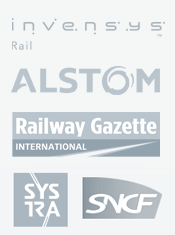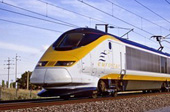
News

High-speed rail development in Britain
29th July 2009
Trains started running at over 200 km/h in regular service in Britain in 2003, using the first section of the Channel Tunnel Rail Link. Completion of this line, renamed HS1 - we hope presciently - in November 2007 is associated in the public eye with the Royal opening of St Pancras station.
29th July 2009
Appealing to a national fondness for nostalgia as fashioned by the likes of Sir John Betjeman alongside a rediscovery of engineering prowess, this was the tipping point, we believe, in public support for the radical idea that the Britain too could have a high-speed rail network.
The truth is that our first line, HS1, was born of political embarrassment, and its planning followed a tortuous course. There is much to admire in the ultimate achievement of its delivery, which was achieved through a combination of French technological know-how, (tried and tested) American programme management and British engineering design skills. But there is also much to learn from the HS1 experience, especially as the nation contemplates its next step on the path to a national high-sped rail network.
Of course Britain has come rather late to high-speed rail, and so there is much to learn as well from the experience of others from around the world. We may miss the prestige of being first, but the signpost to success with rail systems is along an evolutionary path, which is why the track gauge, for instance, are unchanged since they were first formulated in Britain 200 years ago. So there is a great advantage to us in being able to listen and learn from the experiences of others. Hence the HSR Summit on September 9th.
Meanwhile, HS1 is prospering, with new services and more in prospect. Its owning company been recently 'corporatised' in preparation for a market sale in due course. Government might expect to recoup up to half of its capital outlay from the disposal.
The principal user of HS1 is the Eurostar service between London and Paris/Brussels. This has achieved the high market share forecasts in these inter-city markets, but is only much more recently starting to show signs of building market share to destinations deeper into Europe. The recent opening of the high-speed line from Liege to the German border has helped, and soon (we trust) it will be possible to travel much faster from Brussels through to Amsterdam. The market is undoubtedly there for services from London to additional European mainland destinations: the interesting question, given the new open access rules that apply from January 2010, is who is going to provide them.
Also now running on HS1 is a sample of Southeastern's Javelin domestic franchise service, due to launch fully in December 2009. Using new Hitachi Class 395 trainsets, this is an exciting foray into high-speed (well, 225km/h) commuting.
An extension of Britain's HSR network might allow services on HS1 to be extended north or west of London. But this would be simply an additional benefit of creating high-speed rail infrastructure: we have the domestic demand (and the capacity constraints, right across the transport network), the concentration of population centres and even some remarkably linear corridors to justify building HSR lines.
So why haven't we already done so? Well, while the French were creating what would become the TGV network in the 1970s using new routes built parallel to the existing network, the British approach was to develop tilting train technology, with the aim of getting faster speeds out of existing lines. Sadly, just as the first TGV line was opening in France in the early 1980s, the Advanced Passenger Train (APT) was declared a failure.
There are two interesting points arising from the APT debacle. The first is that when planned, in the 1970s, rail services were being progressively retrenched, so the problem of route capacity (which is itself exacerbated by the use of tilting technology on some but not all trains) was not seen as the critical problem that it now is.
The second point is that Virgin's Pendolino service, introduced some 20 years later on to the very route (the West Coast Main Line) for which APT was designed, is by far the busiest - and perhaps the most reliable - tilt technology in operation worldwide. It is creating a huge base market on which high-speed rail can build.
In January this year, the British government took a major step forward. It announced the formation of a new company - High Speed 2 - charged with identifying a route for HSR between London and the West Midlands and potentially beyond. HS2's report is due at the year end, and Ministers have promised a speedy reply. Remarkably, if government commits to a high-speed rail network, it won't find itself opposed by the Conservative (or Liberal Democrat) opposition. The Conservative Party has committed to a public outlay of £15.6bn on HSR should it form the next government.





